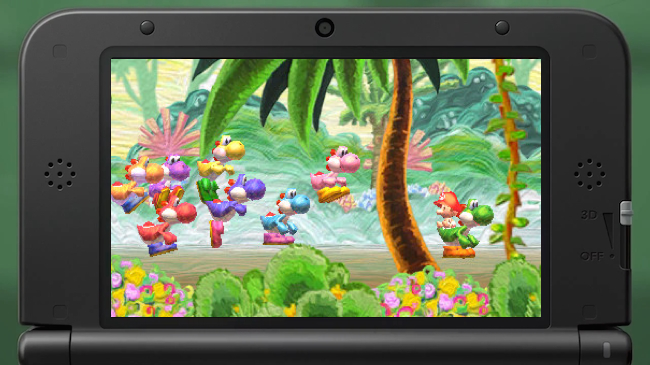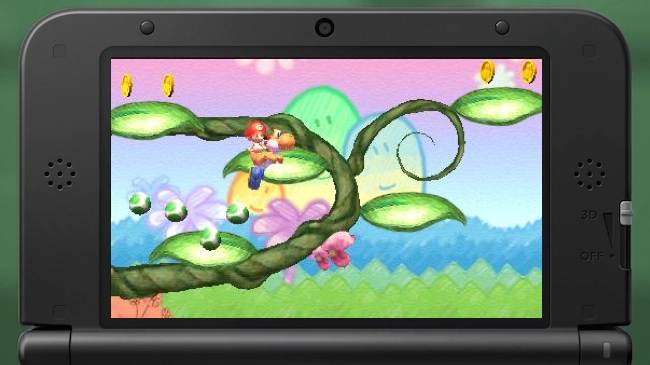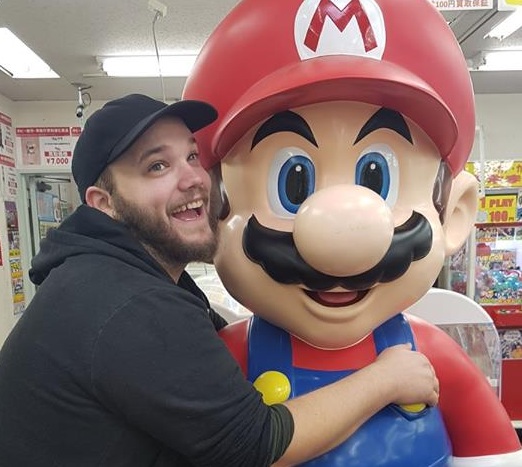
Author’s Note: I would like to note that I began writing this review before I saw the Super Smash Bros. Wii U/3DS Nintendo Direct. I don’t believe it’s going to be the Jesus of gaming, descending from the heavens to breath new life into Nintendo’s first party titles; my lamentations in this article about Nintendo’s recent track record of bad storytelling and bland design, however, clearly isn’t shared among all in-house. I’m actually really excited for the new Smash Bros. I can barely even express it, it’s going to be rad as hell. Yoshi’s New Island, on the other hand…
I was pretty excited when I first heard that the Yoshi’s New Island was being released on the 3DS. In fact, I still go back and play the original SNES game now and again; such is the extent of my love for this part of the Mario franchise. With that being said, I loved Nintendo on the whole when I was growing up, which is probably why it saddens me so much to see them on the decline. Yoshi’s New Island, much the same as their most recent games, isn’t strictly “bad” when judged by its own merits. If this were a totally new IP from Nintendo, I’d actually be pretty impressed with it as a first foray into a new series. Considering that this is the third iteration in this particular sub-series, of an already very well established franchise, I would have expected a lot more than what we actually got.

The narrative is contradictory, and kind of lame to begin with; contributing little to nothing to the overall experience for the title. The design and gameplay were also a relatively-flat, which means that once again the game was pretty enough to draw me in, but stands as another “pretty” disappointment on my shelf that I’ll probably never play again. I guess Nintendo have packed it in as far as story telling is concerned for the foreseeable future, since there’s never a huge amount of it in their games anymore. If you’ve played the other Yoshi’s Island games then you already know the premise for Yoshi’s New Island: Egg Island, a new island (I can almost hear Nintendo shouting “Get it!?”) that the Yoshi’s have taken up residence on, is being terrorised by Baby Bowser after he turned it into his own personal “Vacation Home”. Unfortunately, a la Donkey Kong Tropical Freeze, that’s the last time we’ll hear about that particular part of the story. It truly is amazing how quickly plot points are just abandoned in Nintendo games of late, enough to convince me that Tommy Wiseau is ghost-writing for them.
The main focus of the game, which should have been the only focus of the game, is Baby Mario’s journey to get back to his parents. This part is pretty confusing, because it kind of contradicts the other two games; the game starts with the Stork delivering babies Mario and Luigi to the wrong house before having to double back to the right one, but is then waylaid by Kamek and his goons. The problem with this is that the first game had Mario and Luigi delivered to their parents, and the second game saw them kidnapped and then returned back to those same parents: what’s happened between being happily homed and being delivered to a new home, in a short enough time span for them to still be infants, is some pretty necessary plot information we’re never treated to.

It’s otherwise a fairly boring affair as far as story-telling is concerned. Were it not for the intro clarifying that this game takes place after the others in the series, you’d be forgiven for thinking this was simply an HD re-mastering. The core premise for Yoshi’s New Island is almost identical to that of its SNES predecessor; since the side-plot of Baby Bowser taking the Yoshi’s home as his holiday house is never revisited, it feels like it’s something they’ve shoe-horned into the story for them to justify making very few changes in the overall design of the previous titles and presenting it as a “new” game. The developers obviously cared so little about it that Kamek himself never once mentions it, instead favoring the stock-standard “bad guy” threats, and he shows up twice in every world.
This is basically a Mario game, which means you already know how it’s going to end; I won’t give away specifics, but you shouldn’t hold your breath for anything amazing. That’s a long wait for something that won’t happen, and barely resolves anything that it raises at the beginning of the game when something happens at all. Yoshi’s New Island really is all about the journey, not the destination, which isn’t a bad philosophy for games to have in general, but the unfortunate downside is that the narrative is an insignificant part of that journey in this game.

If there’s one aspect that Nintendo games have majorly improved upon, it’s the difficulty scaling. Passing levels in Yoshi’s New Island can vary from being short and easy to challenging enough to warrant a few do-overs; with the occasional level that will have you stuck for ages. The real challenge lies in finding the collectibles in each stage, allowing players to choose both how difficult they want the game to be and the pacing of the games progression. This was also present in DK: Tropical Freeze and something I hope continues in future games; the balance that is struck between “hardcore” and “casual” gameplay makes it feel as if the game wasn’t entirely pitched at either.
Instead, it’s more of a “well-rounded” platforming game that successfully caters to a wide ranging audience without watering down the design to simple jumping puzzles and no-risk platforming segments. The levels themselves, without trying to reach 100% completion, can at times be challenging just to reach the end. There isn’t a lot of tension when trying to complete a really hard level, however, because by the time you reach the halfway mark of the first world you’ll have more lives than you could possibly need. There was never a moment for me where the gameplay became really tense, where there was a lot at risk because I had dwindling lives on a particularly hard level. This was disappointing, since the tension of platformers is one of their biggest appeals.

Level design tends to utilise a lot of tried and true ideas from the previous titles in the Yoshi’s Island franchise, intended for this purpose, the only problem is that they use too many of these ideas and originality becomes second-priority. A lot of the changes between titles were mostly superficial: falling, terrain-destroying chain chomps are still present, but they’re on fire now and come from volcanoes in the background; the growing vines which reach up towards secret areas or the next part of the level have been kept in the game, but while they grow outside of a straight line and are visually different, they still serve the same purpose and in the exact same way.
These might only be a couple of examples, but the list is too long to detail in one article, so I’ll just list off a few short points here: Many (too many, perhaps) returning enemies from previous games; levels which bare a striking, and frequent, resemblance to those of the first game; the return of vehicle mini-game sections in a boring abundance. Most of this wouldn’t be so much of an issue except that it’s meant to be an entirely different island, giving a chance for an entirely fresh design, and instead they’ve phoned it in with “safe” decisions. There are further issues still, with the stuff they’ve left in: The vehicle mini-games, for instance, aren’t as challenging (unless you count forced use of gyro-controls as “challenging”) or as fun as those from the first two games, and they also feel kind of pointless since half the time they’re completely voluntary and all you get from them are extra lives.

The game has also completely removed the mini-games that were present in the first two games, arguably the greatest parts of those games, and used more vehicle levels as a substitute. If there’s a level of hell reserved specifically for game developers, the person who made that nugget of an executive decision has a special spot waiting just for them. Nintendo has some great ideas that they’ve been using to tweak the difficulty level of the game to cater to a wider audience, without losing appeal for either major demographic of the gaming community, but it’s certainly a method that needs some fine-tuning. The circle pad is not your friend in this game, as it certainly wasn’t mine; the sensitive little bastard will have you constantly ground pounding into oblivion, misfiring eggs, and tip-toeing off ledges. I feel like more care could have been taken when designing the controls for the circle pad to avoid these issues, but the D-Pad is a great alternative and is probably the best way to play the game. When you’re using controls that aren’t actively fighting against the player, the game handles exceptionally well and I didn’t have any problems that were caused by bad control or paerticular awful character handling.
I breezed through my first play through, clocking it in maybe a little over six hours of gameplay, and realised that the greatest value in the game is its replayability: I had only 100%’d a single level out of the forty eight that are available when I had finished the game for the first time. That wasn’t for lack of trying either, and there were many times when I abandoned any effort to collect everything because I was just wanted to finish the level and move on. Subsequent playthroughs would see me retry certain levels over and over, trying to collect every item, sometimes with success and sometimes without, and this was absolutely the most enjoyable part of the game.

Without the hunt for collectibles, playing through the levels can feel “samey” after awhile as many of the levels lack a major defining feature, mechanic, or theme. This is thankfully broken up by the mini-boss and boss levels; all of which were great fun (even if they also lacked that “memorable moment”). The multi-player mode is a collection of mini-games which are similar to those that were removed from the single player experience; “similar” in the sense that they’re entirely co-operative and could probably be ranked among the least entertaining multiplayer experiences I’ve ever had. The attempt to 100% the game, however, ranged from being a fun, leisurely experience, to tearing at my face in frustration, which, in turth, is actually a pretty great range for a platformer.
The game auto-saves item progress between sessions for each level, though, which means you can focus on collecting one item per play through, making it a bit easier to work towards 100% completion. Some people might think that this feature detracts from the challenge somewhat, that not having to collect everything in one play through is kind of “cheap” or “casual.” Those people clearly haven’t stared into the face of this games uncaring eyes, with it’s puzzles that prevent backtracking, it’s barriers that force restarts, and the absolute glee with which it unexpectedly springs both of these on you. Without this last feature, the game would be significantly harder to beat and would probably have made me hate it, myself, and everything(one) else around me, just for having tried.
The soundtrack in Yoshi’s New Island was likely the “worst” part of the visual/audio appeal, in my opinion. It didn’t particularly put me off the game; it just didn’t grip my attention or fit the game’s atmosphere very well. I listened to as much of the music in the game as I could tolerate, but most of the time, I would prefer to listen to something else while playing the game. It otherwise looks fantastic, though, which is something I’ve just begun to expect from Nintendo of late. In truth, were it not for the upcoming release of Smash Bros. and a few other promised first-party titles, you would be forgiven for thinking that their Wii-U line-up has just been an elaborate plea, trying to communicate that they’re sick of making video games and really just want to make animated films.
 Balanced difficulty scaling
Balanced difficulty scaling Great visual appearance
Great visual appearance Precise D-Pad controls
Precise D-Pad controls High level of replayability
High level of replayability
 Monotonous gameplay
Monotonous gameplay Uninteresting music
Uninteresting music Overused level design
Overused level design Imprecise circle pad controls
Imprecise circle pad controls
I haven’t lost hope in Nintendo: Smash Bros., the promise of a new Zelda on the Wii U somewhere on the distant horizon, and the potential of the virtual console (if they ever fully realise it). These are all things that make me think they’ve still got a shot at pulling themselves out of the slump they seem to have landed themselves in at the beginning of this generation of consoles. Games like Yoshi’s New Island, however, are making some pretty sizable dents in my sunny optimism. The game had a lot of promise and given what it’s predecessors had delivered, I expected a lot more from this game, which I just didn’t get. Considering this is a first party title, and it’s not the first of late to have fallen short of the mark, it’s disappointing to see this kind of performance from Nintendo.
On the flip-side, though, while these games aren’t exactly keeping me enthralled with their gameplay and design, continuity errors in the story (like what’s going on with that incompetent Stork? Or why are Mario and Luigi getting an exchange of parents?) leave gaping holes that usually provoke me to ask some really interesting questions.











